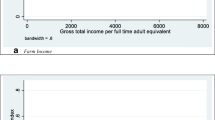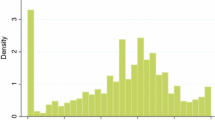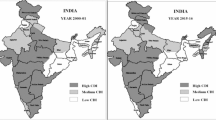Abstract
Micro- and macroeconomic evidence suggest that the promotion of agricultural diversification in agriculture-based developing countries is beneficial. At the microeconomic level, increased agricultural diversification promotes human nutrition and raises household incomes, while allowing farmers to adapt to the challenges posed by climate change. Using Malawi as a case study, we analyzed the recent patterns and determinants of farm level crop diversification in order to better understand how policies impact on diversification and how they can be better formulated or implemented to effectively promote diversification. The study used descriptive and econometric approaches to study crop diversification. Data from two nationally representative household surveys, which covered cropping seasons in 2004/05 and 2010/11, show that crop diversification has deteriorated nationally in different Agricultural Development Divisions (ADDs), although beneficiaries of the widely-implemented Farm Input Subsidy Program (FISP) have become more diversified. The study also found that crop diversification varies significantly across agro-ecological zones. Results also indicate that deliberately targeted policies lead to more commercially orientated crop diversification. We conclude that further crop diversification could be promoted among different types of farmers with the aim of contributing to economic growth, risk reduction, and nutrition security in Malawi.

Similar content being viewed by others
Notes
The term crop diversification should not be confused with crop diversity. Crop diversity is more correctly used in the context of variance in the genetic characteristics of agricultural plant species and as such is an aspect of biodiversity. Crop diversification, as explained in the text, relates to the expansion of the number of activities undertaken within an agricultural production system, in this instance, the number of crops cultivated.
We introduced crop diversification indexes later in the study. The basic principle, however, is that a farming household with two crop enterprises is more diversified than one with only one crop enterprise. Furthermore, a household with two crop enterprises where each crop is allocated half of the total cropland is considered more diversified than a household that allocates 90% of land to one crop and 10% to another (Joshi et al. 2003).
The Malawi Farm Input Subsidy Program (FISP) started in 2005 in order to stimulate effective demand for agricultural inputs and achieve food self-sufficiency by subsidizing fertilizer, maize and legume seed to smallholder farmers (Chibwana 2013).
Legumes are the most widely intercropped crops.
In all cases in this paper, we advise and conform to the strict interpretation of the p-value according to Wasserstein and Lazar (2016).
An ADD is a geographic region covering districts that have similar agro-ecological characteristics. In Malawi, there are 8 ADDs, 28 districts and 3 regions. Regions are larger than ADDs while ADDs are larger than districts.
Karonga has around 766,500 ha of land while Salima has 650,000 ha. Blantyre has over one million ha, while Mzuzu is the largest ADD, with close to two million hectares. An anomaly here is Shire Valley, which only has 685,000 ha but is the second most diversified region in Malawi.
References
Aberman, N., Meerman, J., & Benson, T. (2015). Mapping the linkages between agriculture, food security, and nutrition in Malawi. Washington, DC: International Food Policy Research Institute (IFPRI).
Banerjee, G. D., & Banerjee, S. (2015). Crop diversification: An exploratory analysis. In M. Gosh, D. Sarkar, & C. Roy (Eds.), Diversification of agriculture in eastern India, India studies in business and economics (pp. 37–57). New Delhi: Springer.
Benin, S., Smale, M., Pender, J., Gebremedhin, B., & Ehui, S. (2004). The economic determinants of cereal crop diversity on farms in the Ethiopian highlands. Agricultural Economics, 31(2–3), 197–208.
Birthal, P. S., Joshi, P. K., Roy, D., & Thorat, A. (2013). Diversification in Indian agriculture toward high-value crops: The role of small farmers. Canadian Journal of Agricultural Economics, 61(1), 61–91.
Bittinger, A. K. (2010). Crop diversification and technology adoption: The role of market isolation in Ethiopia. USA: Montana State University Retrieved from https://scholarworks.montana.edu/xmlui/bitstream/handle/1/928/BittingerA0510.pdf?sequence=1.
Breisinger, C., Thomas, M., & Thurlow, J. (2009). Social accounting matrices and multiplier analysis: An introduction with exercises. Washington DC: International Food Policy Research Institute.
Chibwana, C. (2013). Measuring the impacts of Malawi’s farm input subsidy programme. African Journal of Agricultural and Resource Economics, 9(2), 132–147.
Chibwana, C., Shively, G., Fisher, M., Jumbe, C., & Masters, W. A. (2013). Measuring the impacts of Malawi’s farm input subsidy programme. African Journal of Agricultural and Resource Economics, 9(2), 132–147.
Chirwa, E. W. (2005). Adoption of fertiliser and hybrid seeds by smallholder maize farmers in southern Malawi. Development Southern Africa, 22(1), 1–12.
Chirwa, E. W. (2007). Sources of technical efficiency among smallholder maize farmers in southern Malawi. Nairobi: The African Economic Research Consortium.
Chirwa, E., & Dorward, A. (2013). Agricultural Input Subsidies. UK: Oxford University Press.
Coelli, T., & Fleming, E. (2004). Diversification economies and specialisation efficiencies in a mixed food and coffee smallholder farming system in Papua New Guinea. Agricultural Economics, 31(2–3), 229–239.
Conroy, A., Blackie, M., Whiteside, A., Malewezi, J., & Sachs, J. (2006). Poverty, AIDS and hunger: Breaking the poverty trap in Malawi. New York: Springer.
de Janvry, A., & Sadoulet, E. (2010). Agricultural growth and poverty reduction: Additional evidence. World Bank Research Observer, 25(1), 1–20 Retrieved from http://wbro.oxfordjournals.org/cgi/content/abstract/25/1/1.
Deininger, K., & Byerlee, D. (2012). The rise of large farms in land abundant countries: Do they have a future? World Development, 40(4), 701–714.
Devereux, S. (2007). The impact of droughts and floods on food security and policy options to alleviate negative effects. Agricultural Economics, 37, 47–58.
Diao, X., Headey, D., & Johnson, M. (2008). Toward a green revolution in Africa: What would it achieve, and what would it require? Agricultural Economics, 39, 539–550.
Dorward, A. (2006). Markets and pro-poor agricultural growth: Insights from livelihood and informal rural economy models in Malawi. Agricultural Economics, 35(2), 157–169.
Filipski, M., & Taylor, J. E. (2012). A simulation impact evaluation of rural income transfers in Malawi and Ghana. Journal of Development Effectiveness, 4(1), 109–129.
Gaigne, C., Le Gallo, J., Larue, S., & Schmitt, B. (2012). Does regulation of manure land application work against agglomeration economies? Theory and evidence from the French hog sector. American Journal of Agricultural Economics, 94(1), 116–132.
Gould, W. (2016). Can you explain Chow tests? Retrieved from http://www.stata.com/support/faqs/statistics/chow-tests/.
Government of Malawi (2011). Malawi agricultural sector wide approach. Lilongwe: Government of Malawi. Retrieved from ftp://ftp.fao.org/tc/tca/CAADPTT/CAADP-Implementation/CAADP-Post-Compact/Investment Plans/National-Agricultural-Investment-Plans/Malawi-Post-Compact-Investment-Plan.pdf
Government of Malawi (2013). Malawi National Export Strategy (Vol. 1). Lilongwe. Retrieved from www.most.mw/files/download/218af383ae2ff3d.
Harvey, C. A., Rakotobe, Z. L., Rao, N. S., Dave, R., Razafimahatratra, H., Rabarijohn, R. H., Rajaofara, H., & MacKinnon, J. L. (2014). Extreme vulnerability of smallholder farmers to agricultural risks and climate change in Madagascar. Philosophical Transactions of the Royal Society B: Biological Sciences, 369(1639), 20130089.
Helmers, G., Shaik, S., & Atwood, J. (2003). Social and scale efficiency gains due to vertical integration in the US hog sector. In Southern Agricultural Economics Association Annual Meeting. Alabama. Retrieved from https://core.ac.uk/download/pdf/6530936.pdf.
Hitayezu, P., Zegeye, E. W., & Ortmann, G. F. (2016). Farm level crop diversification in the midlands region of Kwazulu-Natal, South Africa: Patterns, microeconomic drivers and policy implications. Agroecology and Sustainable Food Systems, 40(6), 553–582.
Holden, S., & Lunduka, R. (2012). Do fertilizer subsidies crowd out organic manures? The case of Malawi. Agricultural Economics, 43(3), 303–314.
Ibrahim, H., Rahman, S. A., Envulus, E., & Oyewole, S. (2009). Income and crop diversification among farming households in a rural area of north central Nigeria. Agro-Science, 8(2), 84–89.
Isaacs, K. B., Snapp, S. S., Chung, K., & Waldman, K. B. (2016). Assessing the value of diverse cropping systems under a new agricultural policy environment in Rwanda. Food Security, 8(3), 491–506.
Islam, N., & Rahman, M. (2012). An assessment of crop diversification in Bangladesh: A spatial analysis. Applied Economics Letters, 19(1), 29–33.
Joshi, P. K., Gulati, A., Birthal, P. S., & Twari, A. (2003). Agricultural diversification in South Asia: Patterns, determinants, and policy implications. Discussion Paper No. 57. Markets and Structural Studies Division. Washington D.C.: International Food Policy Research Institute.
Kamanga, B. C. G., Kanyama-Phiri, G. Y., Waddington, S. R., Almekinders, C., & Giller, K. E. (2014). Evaluation and adoption of annual legumes by smallholder maize farmers for soil fertility maintenance and food diversity in central Malawi. Food Security, 6(1), 45–59.
Kasperski, S., & Holland, D. S. (2013). Income diversification and risk for fishermen. Proceedings of the National Academy of Sciences of the United States of America, 110(6), 2076–2081.
Kassie, M. (2014). Low risk, high returns: how adoption of crop diversification and minimum tillage is a win-win for smallholder farmers in Malawi. Socioeconomics Program Policy Brief. International Maize and Wheat Improvement Center (CIMMYT). Retrieved from http://aciar.gov.au/aifsc/sites/default/files/images/policy-brief_5_0.pdf.
Kent, R., & Poulton, C. (2008). Marginal farmers, a review of the literature. School of Oriental and African Studies and Concern Worldwide. Retrieved from https://www.concern.net/sites/default/files/resource/2009/04/3573-marginalfarmers_literature_review.pdf.
Kishindo, P. (2004). Customary land tenure and the new land policy in Malawi. Journal of Contemporary African Studies, 22(2), 213–225.
Lea, N., & Hanmer, L. (2009). Constraints to growth in Malawi. Southern Africa Poverty Reduction and Economic Management Unit. Washington, DC: Africa Region, The World Bank.
Lin, B. B. (2011). Resilience in agriculture through crop diversification: Adaptive management for environmental change. Bioscience, 61(3), 183–193.
Lunduka, R., Ricker-Gilbert, J., Shively, G., & Jayne, T. (2014). Understanding and Improving FISP targeting by part 1: what we already know. IFPRI POLICY BRIEF III, 1–5. Retrieved from http://massp.ifpri.info/files/2014/07/Policy-Brief3_revised_circulated.pdf.
Mapila, M., Kirsten, J. F., Meyer, F., & Kankwamba, H. (2013). A partial equilibrium model of the Malawi maize commodity market. Washington DC: International Food Policy Research Institute.
Marenya, P. P., & Barrett, C. B. (2009). Soil quality and fertilizer use rates among smallholder farmers in western Kenya. Agricultural Economics, 40(5), 561–572.
Matsumoto, A., Merlone, U., & Szidarovszky, F. (2012). Some notes on applying the Herfindahl–Hirschman index. Applied Economics Letters, 19(2), 181–184.
McCord, P. F., Cox, M., Schmitt-Harsh, M., & Evans, T. (2015). Crop diversification as a smallholder livelihood strategy within semi-arid agricultural systems near Mount Kenya. Land Use Policy, 42, 738–750. https://doi.org/10.1016/j.landusepol.2014.10.012
Messina, J., Peter, B. G., & Snapp, S. S. (2017). Re-evaluating the Malawi farm input subsidy Programme. Nature Plants, 3, 17013.
Mhango, W. G. (2011). Nitrogen budgets in legume based cropping systems in Northern Malawi. USA: PhD thesis, Michigan State University.
Ministry of Agriculture and Food Security (MoAFS). (2012a). Guide to agricultural production and resource Management in Malawi. Lilongwe: Government of Malawi.
Ministry of Agriculture and Food Security (MoAFS). (2012b). Agricultural Statistical Bulletin. Lilongwe: Government of Malawi.
Minot, N., Epprecht, M., Tran, T. T. A., & Le, Q. T. (2006). Income diversification and poverty in the northern uplands of Vietnam. Washington DC: International Food Policy Research Institute.
Mukherjee, S., & Benson, T. (2003). The determinants of poverty in Malawi, 1998. World Development, 31(2), 339–358.
National Statistics Office (2005). Malawi second integrated household survey (IHS-2). Zomba: Government of Malawi. Retrieved from http://www.eldis.org/vfile/upload/1/document/1110/Malawi-second-integrated-household-survey-2004-20051.pdf.
National Statistics Office. (2012). Third integrated household survey report. Zomba: Government of Malawi Retrieved from http://siteresources.worldbank.org/INTLSMS/Resources/3358986-1233781970982/5800988-1271185595871/IHS3_Report.pdf.
Ndhlovu, D. E. (2010). Determinants of farm households’ cropland allocation and crop diversification decisions: the role of fertilizer subsidies in Malawi. Retrieved from http://agris.fao.org/agris-search/search.do?recordID=NO2010262513#.WGT-97lKIPs.mendeley.
Njoloma, H. M., Kita, I., Kitamura, Y., & Aoyagi, S. (2011). Effect of climate change on Rainfed maize production: Assessment of maize production vs. a changing rainfall pattern in Malawi. Journal of Rainwater Catchment Systems, 16(2), 25–37.
Pauw, K., & Thurlow, J. (2014). Malawi’s farm input subsidy program: where do we go from here? MaSSP Policy Note 18 (March 2014), Malawi Strategy Support Program, International Food Policy Research Institute (IFPRI).
Pauw, K., Thurlow, J., Bachu, M., & van Seventer, D. E. (2011). The economic costs of extreme weather events: A hydrometeorological CGE analysis for Malawi. Environment and Development Economics, 16(2), 177–198.
Pauw, K., Dorosh, P. A., & Mazunda, J. (2013). Exchange rate policy and devaluation in Malawi: IFPRI Discussion Papers, (March). Retrieved from http://ideas.repec.org/p/fpr/ifprid/1253.html.
Pellegrini, L., & Tasciotti, L. (2014). Crop diversification, dietary diversity and agricultural income: Empirical evidence from eight developing countries. Canadian Journal of Development Studies/Revue Canadienne D’études Du Développement, 5189, 1–17.
Pingali, P. L. (2012). Green revolution: Impacts, limits, and the path ahead. Proceedings of the National Academy of Sciences, 109(31), 12302–12308.
Rahman, S. (2009). Whether crop diversification is a desired strategy for agricultural growth in Bangladesh? Food Policy, 34(4), 340–349.
Roland-holst, D., & Park, C. (2015). Myanmar: Long term scenarios for sustained macroeconomic growth. Manila: Asian Development Bank.
Saint-Macary, C., Keil, A., Nielsen, T., Birkenberg, A., Van, L. T. A., Van, D. T. T., et al. (2014). Linkages between agriculture, poverty and natural resource use in mountainous regions of Southeast Asia. In H. L. Frohlich, P. Schreinemachers, K. Stahr, & G. Clemens (Eds.), Sustainable land use and rural development in Southeast Asia: Innovations and policies four mountainous areas (Vol. 34, pp. 76–77). London: SpringerLink. https://doi.org/10.1659/mrd.mm132.
Save the Children (2008). The practitioners’ guide to the household economy approach. Regional Hunger and Vulnerability Programme. Save the Children. Retrieved from http://tinyurl.com/gnf3ek8.
Shiferaw, B., Tesfaye, K., Kassie, M., Abate, T., Prasanna, B. M., & Menkir, A. (2014). Managing vulnerability to drought and enhancing livelihood resilience in sub-Saharan Africa: Technological, institutional and policy options. Weather and Climate Extremes, 3, 67–79.
Simpson, E. H. (1949). Measurement of diversity. Nature, 163, 688.
Simtowe, F., Zeller, M., & Diagne, A. (2009). The impact of credit constraints on the adoption of hybrid maize in Malawi. Review of Agricultural and Environmental Studies, 90(1), 5–22.
Singh, N. P., Bantilan, C., & Byjesh, K. (2014). Vulnerability and policy relevance to drought in the semi-arid tropics of Asia – A retrospective analysis. Weather and Climate Extremes, 3, 54–61.
Snapp, S. S., & Fisher, M. (2015). "filling the maize basket" supports crop diversity and quality of household diet in Malawi. Food Security, 7(1), 83–96.
Tankari, M. R. (2017). Cash crops reduce the welfare of farm households in Senegal. Food Security, 9(5), 1105–1115. https://doi.org/10.1007/s12571-017-0727-6.
Tobin, J. (1958). Estimation of relationships for limited dependent variables. Econometrica: Journal of the Econometric Society, 26(1), 24–36.
US Department of Agriculture (2016). Malawi Food Economy Zones Malawi FEZ map explanations. United States Department of Agriculture. Retrieved from http://www.pecad.fas.usda.gov/rssiws/al/malawi_economy.pdf.
Verduzco-Gallo, I., Ecker, O., & Pauw, K. (2014). Changes in food and nutrition security in Malawi: Analysis of recent survey evidence (Vol. 6). Washington, DC: International Food Policy Research Institute.
Waldman, K. B., Ortega, D. L., Richardson, R. B., Clay, D. C., & Snapp, S. (2016). Preferences for legume attributes in maize-legume cropping systems in Malawi. Food Security, 8(6), 1087–1099.
Wasserstein, R. L., & Lazar, N. A. (2016). The ASA's statement on p-values: Context, process, and purpose. The American Statistician, 70(2), 129–133.
Wooldridge, J. M. (2013). Introductory econometrics. Cambridge: MIT Press.
Zeller, M., Diagne, A., & Mataya, C. (1998). Market access by smallholder farmers in Malawi: Implications for technology adoption, agricultural productivity and crop income. Agricultural Economics, 19(1), 219–229.
Author information
Authors and Affiliations
Corresponding author
Ethics declarations
Conflict of interest
The authors declare no conflicts of interest.
Appendix
Appendix
Rights and permissions
About this article
Cite this article
Kankwamba, H., Kadzamira, M. & Pauw, K. How diversified is cropping in Malawi? Patterns, determinants and policy implications. Food Sec. 10, 323–338 (2018). https://doi.org/10.1007/s12571-018-0771-x
Received:
Accepted:
Published:
Issue Date:
DOI: https://doi.org/10.1007/s12571-018-0771-x




